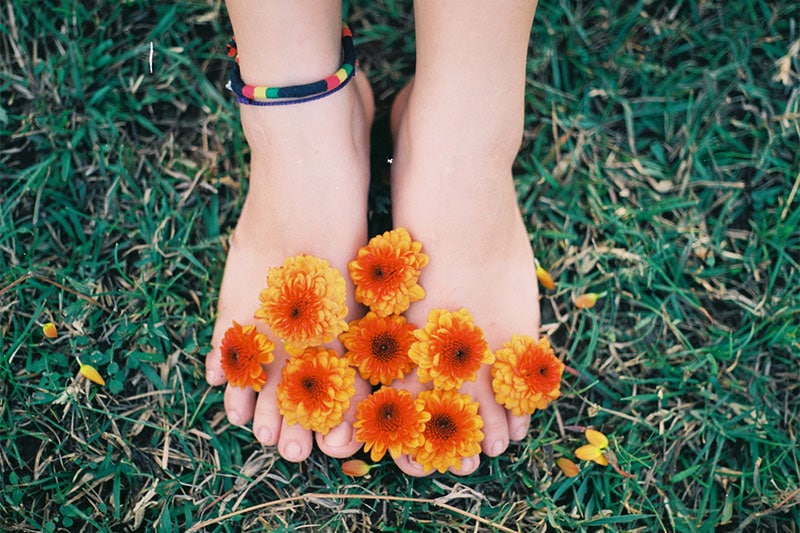
(Image: Khánh Hmoong)
Have you ever had a body part that you hated? A body part that people kept criticizing, even though it’s simply a natural part of your body?
I used to hate my feet when I was younger. The reason was because of my feet size. They are larger than the average Asian woman’s feet, which are a tiny size 6 or 7 (EU 37-38), even smaller if you look at places like Japan.
Advertisement
On the other hand, my feet are a size 10 (US), or 41-42 EU depending on the shoe cut. Which is normal in the U.S. or Europe, but over here, your feet would be regarded as somewhere between an abomination and a monstrosity, particularly if you are female, and Chinese.
Which was exactly the type of reaction I got growing up. Back when I was a kid (my feet weren’t a size 10 then, but probably bigger than the average girl), I always had difficulty getting shoes my size. When I was 9-10, my mom would always go to this shoe store to buy shoes for the family. I remember standing by the girl’s section each time and look longingly at the Mary Janes and pumps, which had cute, feminine designs. As a little girl, I didn’t understand why I couldn’t wear them, except that they didn’t have my size. As a little girl, I thought that perhaps those shoes weren’t for me, and I wasn’t good enough for them.
When I was 12-13, I had the first shaming encounter about my feet. I recall my mom taking me shoe shopping at the neighborhood near our home. As she checked out a shop, she asked the shopkeeper to get my size. The shopkeeper looked at my feet, then exclaimed loudly about how big they were, like they were the greatest abomination of mankind.
As a 12-13, I wasn’t old enough to understand what was going on, in that I didn’t understand what she was exclaiming about (my feet are big? so?). However, I was capable of feeling shame. I felt my face turn red as I felt really uncomfortable, wishing that we could just leave. But my mom insisted that the person get the largest size for me to try.
She did. They didn’t fit.
Seeing this, the shopkeeper indignantly grabbed her shoes and started wiping the insoles as she said loudly, “Look, you dirtied my shoes!” My mom just said that we’d check out other shops instead, grabbed me, and we left.
This was the first time I felt that something could be wrong with my feet. That my feet were possibly shameful, even disgusting, in this world.
Advertisement
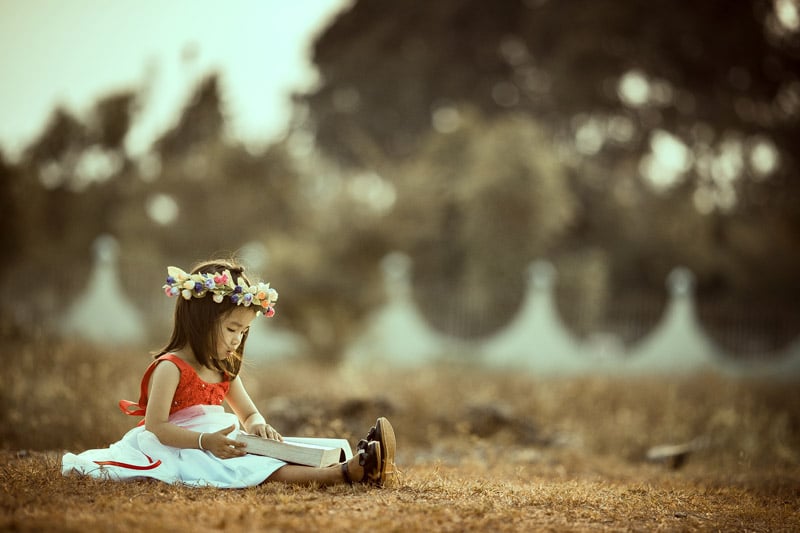
(Image: Mi PHAM)
Criticisms, Insults against My Feet
Subsequently I experienced more incidences where people would criticize me for my feet. For example when with friends, whenever shoes/feet came up as a topic, the girls would start comparing their feet and then say to me, “Wow, your feet are so big” in a derogatory way. Girls with smaller feet were praised as if they were some accomplishment that they had earned, when they weren’t.
When trying to buy some shoes, the shop assistant would glance at my feet and then exclaim, “Your feet are so big!” before going, “Sorry, we don’t have your size.”
When at friends’ houses, people would sometimes compare the feet and shoe sizes of girls and again praise the girls with small feet, while exclaiming about my feet size. One such comment came from a guy with bigger feet than mine — we were the same height — but for some reason his big feet were okay, but mine weren’t.
Eventually when I was 17-18, after countless rejections and unsolicited criticisms about my feet, I began to hate my feet. I would resist discussions about feet so that they wouldn’t swing into some foot-comparison exercise, which seemed to be common here. I stopped trying to buy shoes here (or anywhere in Asia) and turned to online shopping where there are bigger-size shoes. I would admire girls who could simply try the shoes on display and buy whatever they liked because I myself struggled with buying shoes of any kind in Singapore where the largest shoe size for ladies was a mere 9.
My only solace was in unisex sports shoes, sandals, and — something I really hated — squeezing my feet into covered shoes that were one size too small, which would result in the bruising of my toe nails later. When I was with others, if I was barefooted, my natural reaction would be to curl up my toes and scrunch my feet so that no one would ever notice my feet.
My biggest wish was for my feet to disappear, to never get any attention, and to stop being criticized like they were some object.
The Stigma Against Big Feet
The weirdest thing is that despite all these comments, my feet are actually not big. They are not big as much as they are long, longer than the average Asian woman’s feet that is. I have long toes, where my second toe is 0.8-0.9 cm longer than my big toe, which then adds ½-1 size to my overall feet size. Case in point: the width of my foot is slimmer than some of my friends’ feet which are sizes 7-8, and the same as a friend’s foot which is a size 6.
Advertisement
It would seem that the societal stigma is more about the feet length than width.
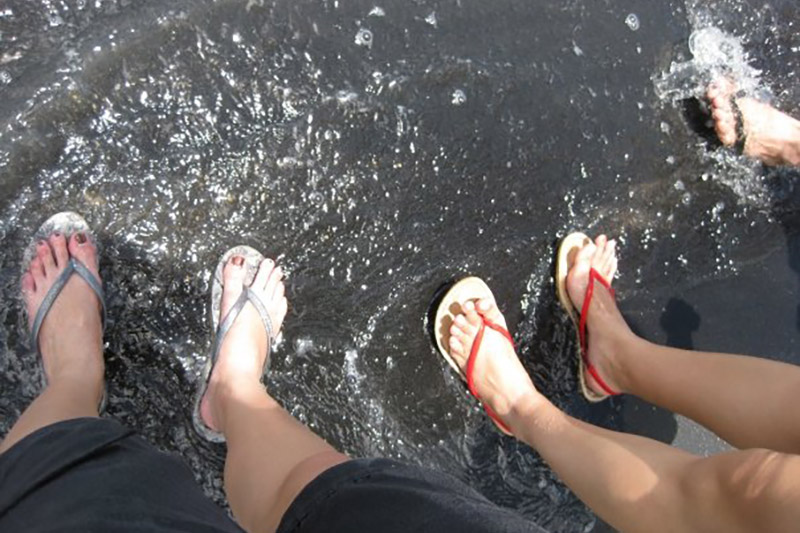
Me and my friends in Langkawi (2009). I’m the one with red slippers.
Big or long, it doesn’t matter as I would get ostracizing comments about my feet, like I had committed a crime. Women, strangers and friends alike — though never my mom — would make it their business to criticize my feet, even though I never asked for their opinion. Once I went for a foot massage and the masseuse told me that my feet looked like an alien’s.
On the other hand, what is seen as the “feet ideal” here is small feet. Very small feet. There is a Chinese idiom called “娇小玲珑” (jiao1 xiao3 ling2 long2) which directly translates to “small, delicate, exquisite.” What the idiom means is that small (women) is the representation of elegance, beauty, and exquisiteness.
Hence, petite women, women with small hands and feet, and skinny women are often seen as the mark of beauty be it in China, Hong Kong, or Singapore. Taiwan variety shows revolve around such ideals; sometimes an entire episode can be about criticizing women’s looks, skin, leg sizes, and so on. Once my Chinese teacher talked about the concept of 娇小玲珑, where she said — as a matter of fact — that small/petite women with small hands and feet are the ones who are beautiful. And she was relaying this to a class of young students who were 13-14 years old.
Small Feet = Beauty
Perhaps this notion of beauty can be traced all the way back to ancient China, where mothers would bind their daughters’ feet in a painful process called “foot binding.” This resulted in life-long disabilities and has since been banned.
The reason for foot binding was because having small bound feet was seen as beautiful. The ideal was a tiny 3 Chinese inches (10cm or 4 Western inches), where feet with this length would be called 三寸金莲 (san1 cun4 jin1 lian2) or “3-inch golden lotuses.” Small bound feet were seen as erotic to men due to the dainty way a woman was forced to walk. Having small bound feet was a prerequisite to find a husband, and many women, their families, and their husbands took pride in their tiny feet.[1][2]
Advertisement
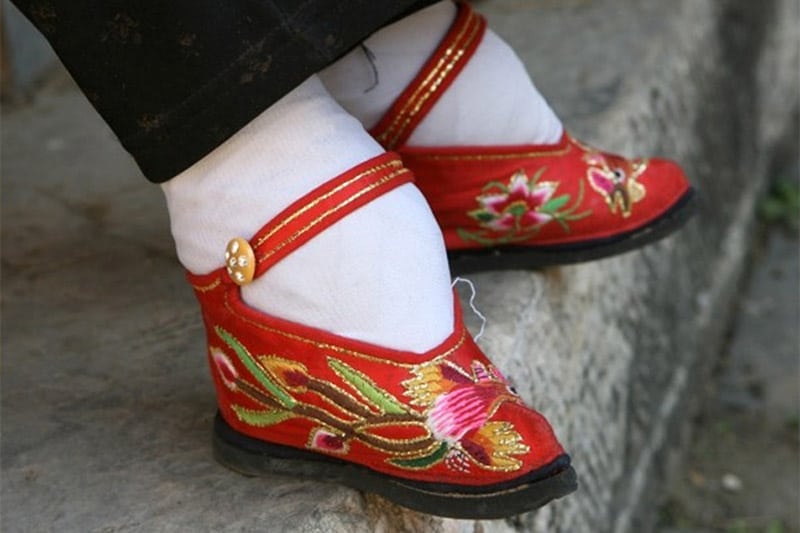
The 3-inch lotus feet, only achievable through painful binding of a girl’s feet since young (Image: AFP)
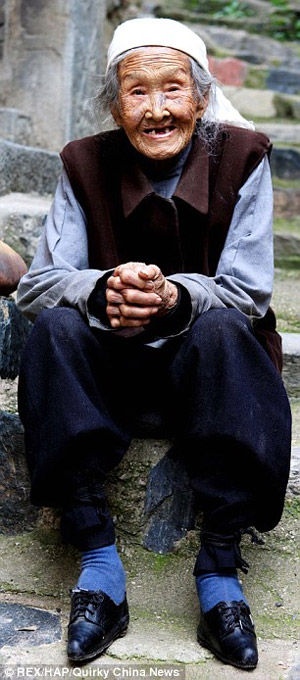
Mdm Han Qiaoni is 102 years old and one of the last women in China who had her feet bound. She was just 2 when her toes were broken and her feet bound.[2] (Image: REX/HAP/Quirky China News)
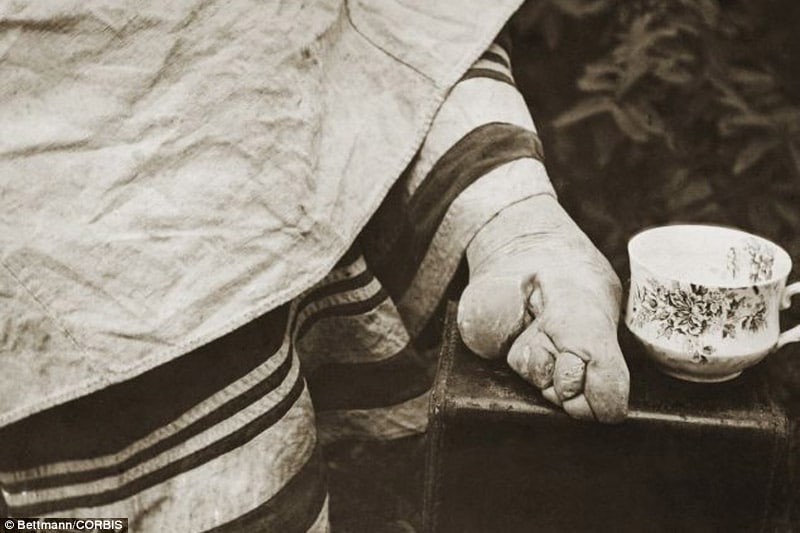
A closeup of a woman’s bound feet without the elegantly embroidered silk shoes typically used to cover them (Image: Bettmann/CORBIS)
While the smaller 3-inch feet might have seemed erotic to men, the process of foot binding was greatly inhumane as the toes would be broken and folded inward, and the arch of the feet forcibly broken. Infection was a serious issue and the feet would be permanently deformed. As many as 10% of girls were thought to have died from infections from foot binding, with the surviving women were prone to falls leading to broken hips; paralysis; and muscular atrophy.[3] The feet were always concealed in their beautiful silk shoes as some men preferred to never see them.
Perhaps this obsession with small feet is not just limited to Asia. In the Western world, the story Cinderella comes to mind, where the Prince finds his love after searching his entire kingdom for the one maiden who could fit into a tiny glass slipper.
If you read the story carefully, Cinderella actually indirectly glorifies small feet as a beauty ideal, as Cinderella, the heroine repeatedly described as beautiful, has feet so tiny that no one could fit into her glass slipper but her. In fact in the Brothers Grimm’s version, the step sisters had to cut off their toes and heel to fit into the slipper and win the Prince’s heart! As we know, the story of Cinderella has been retold for centuries and adapted into countless films, where women of all ages and nationalities see Cinderella’s story as an ideal, and Cinderella herself as a role model.
Incidentally, the oldest documented version of Cinderella is said to come from China[4], so perhaps this whole association of small feet with beauty really all once originated from China.
Advertisement
Becoming Conscious of Beauty Ideals
As I grew older, I continued to be ashamed of my feet, though only subconsciously so as I knew how to mitigate and avoid awkward situations surrounding my feet.
Until one day when I realized that it didn’t make sense for me to feel so ashamed about something that’s my body part, that’s not even within my direct control, that I never once thought was “not beautiful.” I had never thought of my feet as ugly; it was just a notion repeatedly pushed onto me by others.
As I dug into this shame, I realized
- Just because my feet are not small doesn’t mean that there is anything wrong with them or that they are not beautiful. It just means that they do not conform to the average feet size of 6-8 in my country or 6-7 in Asia, and there is really nothing to be ashamed about.
- Virtually all the shops in my country do (did) not have my size because most shops cater for the majority, for the average population need. My needs are simply an outlier of the average woman’s need here, which is why manufacturers and retailers fail to account for my shoe size and needs. This is expected as manufacturers generally create the things with the most market need and demand, due to the need for scale. It doesn’t mean that my body part is shameful, but that I’m simply not in the average market subset when it comes to shoes. (Note: Some shops here have begun carrying bigger sizes, though it is no longer important to me as I barely shop anymore.)
- My feet are their size because they are the best length and width to support my body. I’m 170cm / 5′ 7″ and size 10 is what fits me and frame. Most importantly, my feet are proportional and right for me. On the other hand, the average feet size for local ladies is 6-8 as the average height for ladies here is 160cm / 5′ 3″.[5] If I were to have a feet size of 6-8, I don’t think I would be able to move as quickly as I do, or balance myself as easily.
- The people who criticized me for my feet before were no more the result of their upbringing, education, and environment. They were probably taught that women must have small feet to be regarded as pretty. If this mindset is to be changed, it needs to be done by educating everyone at the fundamental level, not by being angry at those who were/are just results of a broken system and thinking.
As I realized that the source of my shame was nothing but a set of baseless, twisted beliefs, my lifetime held shame, fear, and embarrassment surrounding my feet crumbled away. For the first time, I stopped scrunching my toes/feet unconsciously, something I had always done probably out of shame and fear. I felt lighter, free.
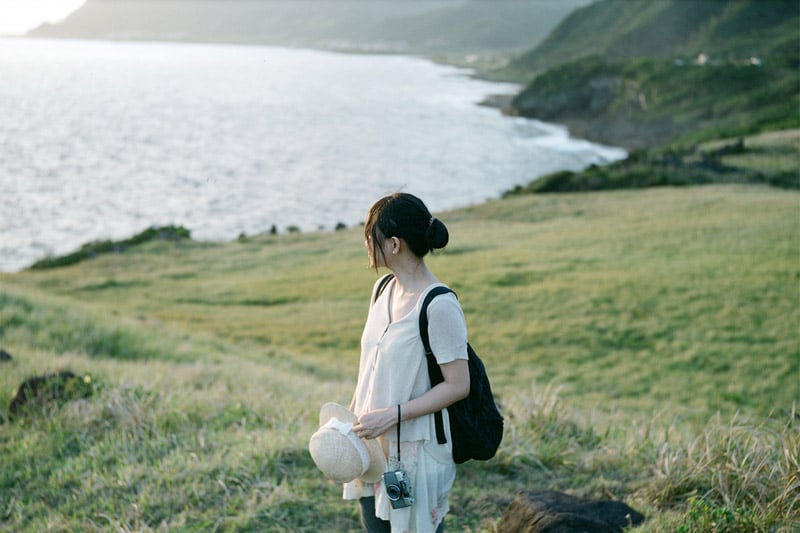
(Image: HaoJan)
What We Can Do
Whether someone’s feet are big or small doesn’t indicate their beauty. Beauty comes in all forms, and in this case, all shapes and sizes of our feet. Beauty is not just reserved for small feet, and certainly not for feet that can only be achieved through foot binding. There are many tall celebrities and models with larger feet sizes of 10, 11, 12, and even higher[7], and their big feet are no less beautiful than smaller feet.
After all, if people are tall, they would naturally have longer or broader feet. To scrutinize and expect everyone to maintain a certain feet size without considering their overall body height and frame is ridiculous. We should not expect others to look the same and conform to the same look but celebrate everyone’s individual look and form.
Yet, the problem that I experienced isn’t just about stigmas against big feet. It’s about the notion of beauty ideals. That somehow there is a certain look or form or feature that is regarded as beautiful in a culture, and that everyone must either alter themselves to fit this look and gain acceptance, or be regarded as disgusting, ugly, lousy, not worthy, and so on.
Yet, notions of beauty are man-made to begin with, typically shaped based on what’s common or not common in society, created to separate the “have’s” from the “have not’s.” For example,
- Pale skin used to be associated with nobility as the aristocrats didn’t have to work in the fields (hence the term “blue blood,” as their skin would be so pale that one could see blue veins).[7]
- Being weighty was seen as very attractive during the Renaissance era and the Tang dynasty. Food was scarce then and being weighty meant that you had enough to eat and could be a potentially rich and healthy mate.[8]
- Subsequently being skinny became seen as very attractive when food became easily available and abundant, and the wealthy had to stand out from the middle class.[9]
- In China during the Song dynasty, tiny bound foot became attractive as the only women who could afford to do that were the ones from wealthy families, as they didn’t need to work in the fields.[10] This later became adopted across all social classes as the standard for beauty.
- Caucasians and their features — high nose bridge, double eyelids, deep-set eyes, pale skin — were and still are generally seen as superior and more attractive in many Asian countries.[11] While there can be many reasons why, I believe part of it is because many Asian countries used to be under the Colonial rule, which created a deep-set mentality that Caucasians or those with Caucasian blood are better, and a deep cultural association that Caucasian-like features are “better” or “more beautiful” than the typical Asian features of round nose, monolids, smaller eyes (due to monolids), or the darker skin tone for certain races, which is in turn perpetuated by media and society. Read: Colonial mentality
For more on changing beauty standards, read this, this, this, and this.
Subsequently, people are then encouraged to alter themselves to gain acceptance and be linked with beauty. This is particularly prevalent among women as there is much pressure on girls and women to achieve a certain “beauty” look, both today and in previous generations, though increasingly so for men too. The beauty industry for women today profits hugely from reinforcing such ideals, getting women to continuously buy makeup, shoes, clothing, handbags, and skin-altering products (such as skin whitening). On the other end, there are the more invasive procedures like plastic surgery, injections, and abrasive treatments.
However, beauty isn’t the result of genetic chance or race or a certain look or feature. Beauty is everywhere, in you and me. If we can stop and celebrate who we are and what we already have as individuals, and stop body shaming based on certain ideals created by men (women) to begin with, we can stop this endless cycle to achieve some “beauty look” when all of us are already beautiful to begin with, and you don’t need to alter yourself to look “more beautiful” than another.
Here’s what we can do at a personal level:
- Recognize that beauty comes in all forms, shapes, and sizes. Every look is beautiful. It is not one look that is more beautiful than another, but that every look is beautiful. I share more here: The Beauty of Self
- Stop judging others by their looks just because they don’t fit a certain mold of beauty. Remember that one’s definition of beauty is no more the result of conditioning ones receives, the media that is consumed, and the people that one interacts with. There is no one look for beauty, but that every look is beautiful.
- Reduce your consumption of beauty goods/services that reinforce such ideals. Other than the fact that there’s no need to, it also fuels such an industry and further reinforces such ideals. For example, skin whitening products fuels the notion that a fairer skin color is “better” when it’s not true. Double eye-lid stickers reinforce the notion that double eyelids are superior to monolids. Surgery for high nose bridge reinforce the preference and mindset that a higher nose bridge is more attractive. Here I’m not saying not to use any beauty products, but to reduce consumption of products that perpetuate negative ideals.
- Celebrate each other’s beauty. When we live in a society where we are made to constantly pit against each other, where women are taught to look a certain way to be more beautiful than others, and where everything is a “contest,” people naturally start criticizing each other, shaming and putting others down, and then make themselves seem better, all in a quest for affirmation, love, and acceptance. I saw this happen in school; it still happens in most parts of society today, especially when it comes to men criticizing women or women criticizing women.
There is no need to do that. We are not competing against each other; we are humans here to live a better life and create a better future for others. Whenever you can, look at your friend(s), point out one thing you love about them/ their features/ their body and tell them how beautiful it is. They will appreciate you for it.
- Educate each other and share the knowledge. While I have written this post and other posts on beauty (that I’ve linked below), I’m only one person and my posts can only go as far as when they are read. Where you can, and if you feel that any of these posts are helpful, share them with your friends and family. Open them up to different ideas of beauty. Educate them on different notions of beauty, and that beauty isn’t just one look or size, but something that everyone already has.
If you happen to have big feet, I want to let you know that your feet aren’t a monstrosity or issue, but a natural part of your body. You should not be hating on your feet when they have been carrying you across distances, quietly carrying the weight of your body, and helping you take your first steps and all your steps in life. Love them, cherish them; they are a part of you. 🙂
If you know people with big-size feet, share with them this post. It may well be something they need. 🙂 Thank you!
Read my other posts: